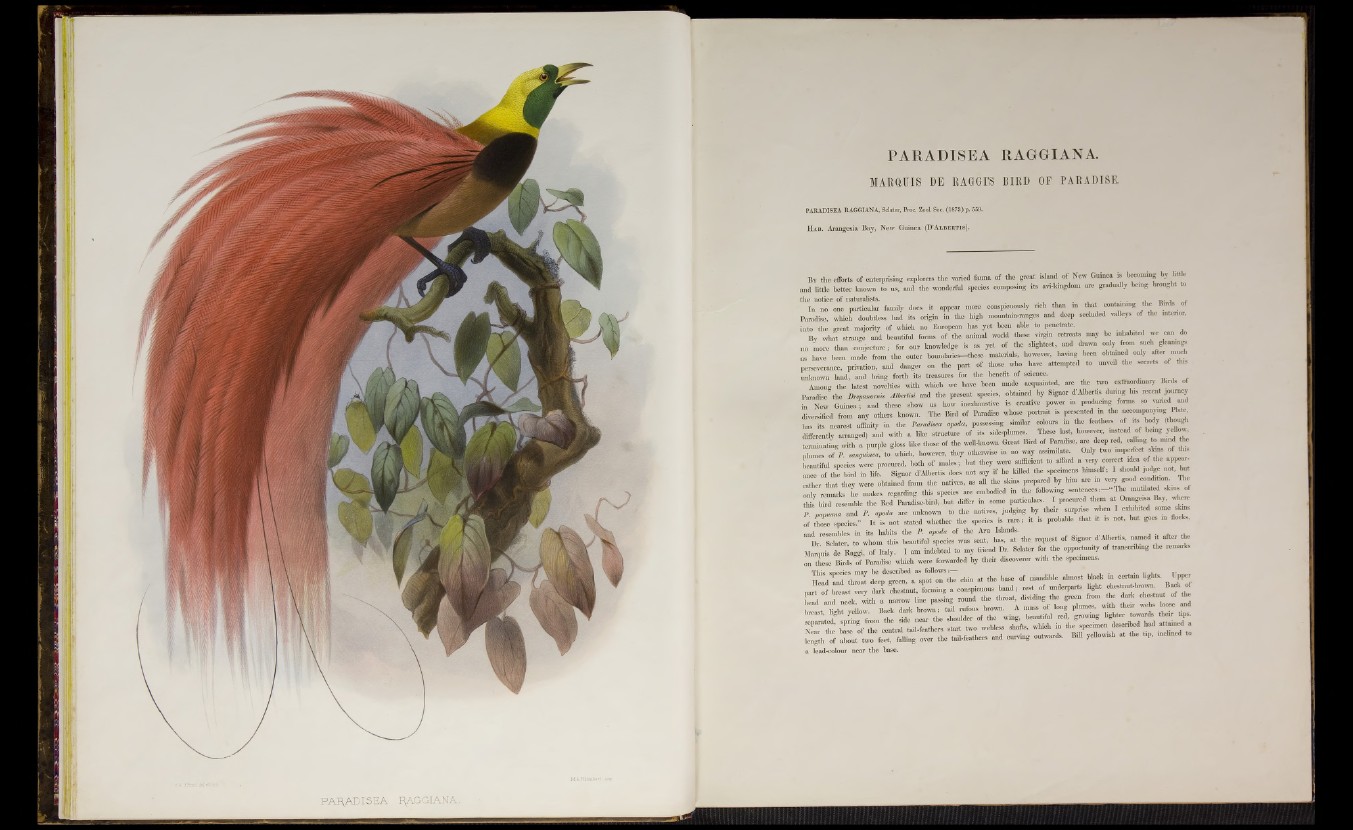
II
111'
PARADISEA RAGGIANA.
MARQUIS DB RAGGI’S BIRD OP PARADISE.
PARADISEA RAGGIANA, Sdater, Eroe. Zool. Soc. (1873) p. 559.
H a b . Arangesia Bay, New Guinea (D'A l b e r t is ).
By the efforts of enterprising explorers the varied fauna of the great island of New Guinea is becoming by little
and little better known to us, and the wonderful species composing its avi-kingdom are gradually being brought to
the notice of naturalists. . . . , -
In no one particular family does it appear more conspicuously rich than m that containing the Birds of
Paradise, which doubtless had its origin in the high mountain-ranges and deep secluded valleys ot the interior,
into the great majority of which no European has yet been able to penetrate. ,
By what strange and beautiful forms of the animal world these virgin retreats may be inhabited we can do
no more than conjecture, for our knowledge is as yet of t o slightest, and drawn only from such glemnnp
as have been made from t o outer boundaries-lhcse. materials, however, having been obtained only after much
perseverance, privation, and danger on t o part of those who have attempted to unvcil t o secrets of t o
unknown land, and bring forth its treasures for t o benefit of science.
Among t o latest novelties with which we have been made acquainted, are t o two eattaordmary Buds of
Paradise t o Drepancrnie Albert«! and the present species, obtained by Signor d'Albertis during Ins recent journey
in New Guinea; and these show us how ineahuustive is creative power in producmg forms so varied and
diversified from any others known. The Bird of Paradise whose portent is p t e t o e d m the «com,pan
has its nearest affinity in t o ParaOwa ap o ia , possessing similar colours m t o feathers (* ° “S
differently arranged) and with a like' structure of its sidc-plumcs. These last, however, instead of being yellow,
terminatog vrith a purple gloss like those of the well-known Great Bird of Pantoe, are deep red, cjlnq; to rnrnd t o
r l„„,M Of P. 8anyai»e«,"to.which, however, they otherwise in no way assimilate. Only two unperfectjfcns of t o
beautiful species were procured, both .of males; but t o y were sufficient to afford a very cermet idea the appearance
of t o bird in life. Signor d'Albertis does not say if he killed t o specimens himself; I shoffid judge not, but
rather that t o y were obtained from the natives, as all the sldns prepared by him are in verygood f g
onfy remarks he makes regarding this species me embodied in t o following s e n to c e s : - ‘‘The mutdatrf skins of
this bird resemble the Bed Paradise-bird;Jlut differ in some particulars. I procured them at Orangeis. Bay, where
P B i and P. ap o * are unknown to t o natives, judging by their surprise when I erhibited some skms
of t o e species.” It is not stated whether t o species is rare; it is probable that it is not, but goes m flocks,
and resembles in its habits the P. apoda of the Aru Islands. _
Dr Sclater, to whom this heautiftd species was sent, has, at the request of Signor d Albertis, | S | | | “ftet
Marquis de Baggi, of Italy. I am indebted to my friend Dr. Sdatar for t o opportunity of transenhmg t o mmarks
on these Birds of Paradise which were forwarded by their discoverer with t o speennens. SdSSX chin at to base of t o d ib le almost' Mack I cetom fights. Upper
nart of breast very dark chestnut, forming a conspicuous bond; rest of underparts light (hestnut-browm Back of
— H ^ t o S t i S W m
length of about two feet, felling over t o tail-feathers and curving outwards. Bill yellows* at t o tap, mclmed
a lead-colour near the base.